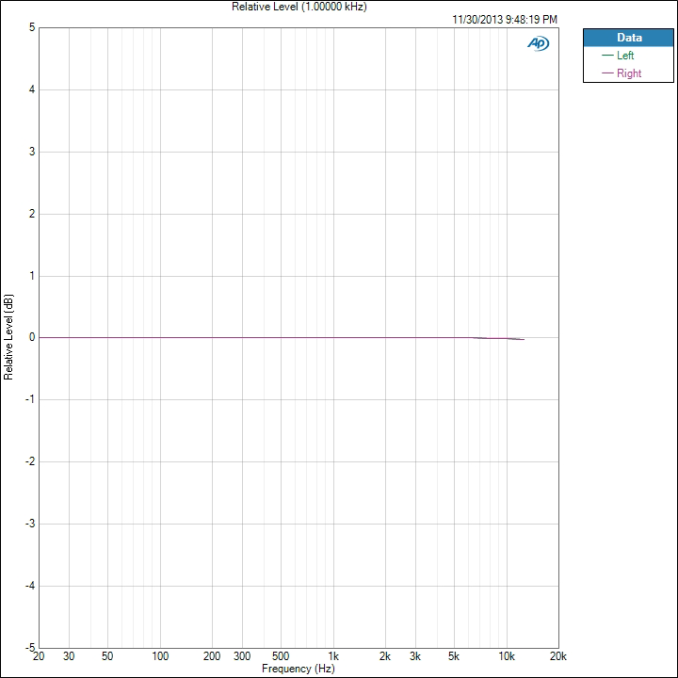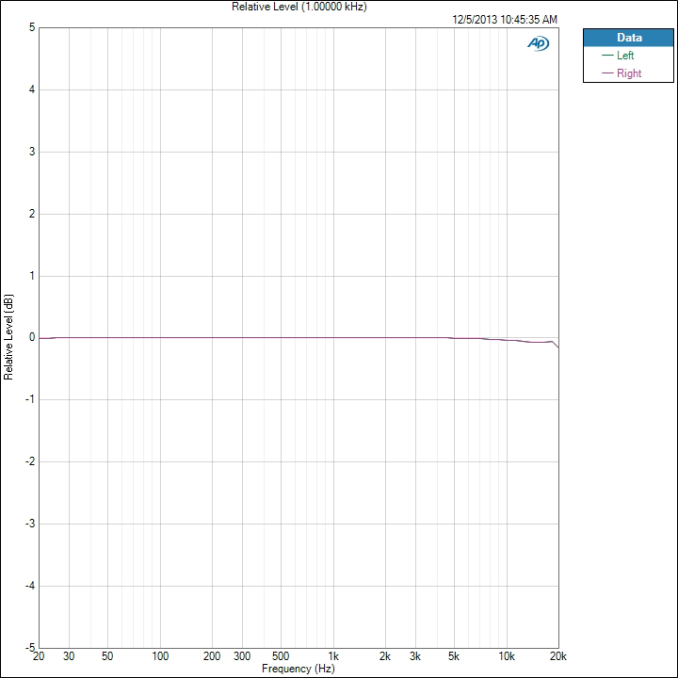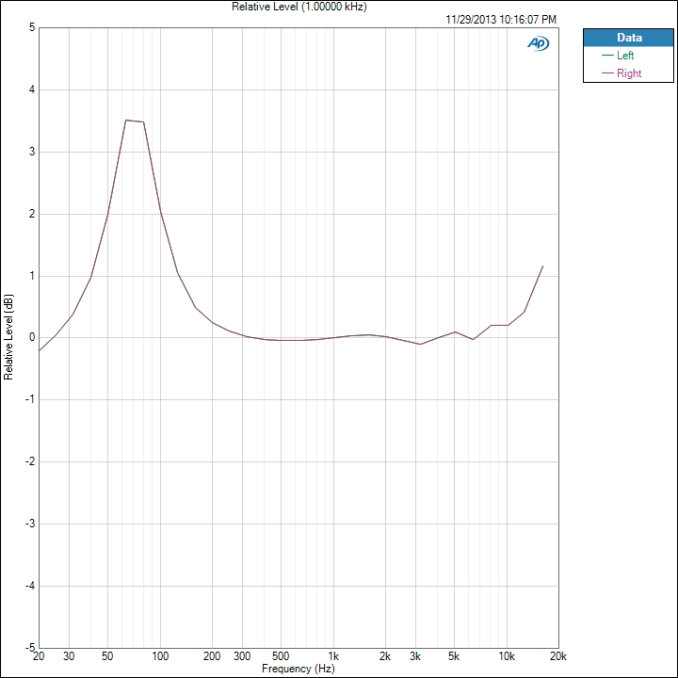Smartphone Audio Quality Testing
by Chris Heinonen on December 8, 2013 5:15 PM EST- Posted in
- Smartphones
- Audio
- Mobile
- Tablets
- Testing
Maximum Level
The maximum output level is derived from the 1kHz test tone used to determine THD+N. The higher the output from the headphone jack, the louder it can drive a pair of headphones. More importantly, having more power available means when you have dynamic music passages that call for power you are less likely to clip the waveform.
There is no chart to show here, just a number that the Audio Precision gives us. In our test data, the most powerful phone was the iPhone 5, at 32.46 mW of power. Next is the Nexus 5 at 22.24 mW, though we can’t drive it that high. Then the Note 3 at 11.81 mW and finally the Galaxy S4 at 3.895 mW. Doubling the power, from 4 mW to 8 mW, produces a 3 dB increase in volume level. 3 dB is the smallest change in volume levels we can easily hear. So even though the iPhone 5 produces 32 mW vs. 4 mW, that is only a 9 dB difference in volume. 10 dB is doubling the volume, so it isn’t even twice as loud. If you have demanding headphones, you will want as much power as you can get.
Frequency Response
To measure the frequency response we measure a set of 61 tones from 20 Hz to 20 kHz. All of these are then equalized to 1 kHz so we can see the maximum deviation from that level. An ideal phone will be perfectly flat here and allow you to adjust this with an EQ setting, or though your taste in headphones. On this test our best performing phone is the Galaxy S4, as seen here.
The total variation from 1 kHz is only 0.014 dB which is very good. The worst performing phone is the iPhone 5, but its variation is only 0.089 dB.
The iPhone 5 also picked up the 20 kHz tone while the Samsung and many others missed it. If we dropped this tone then it might be just as flat. The iPhone 5 test was run slightly differently, as it can't run the Android test program, which might account for this. For a phone with a different response, here is the HTC One with Beats enabled. Other HTC One testing is still in progress as I write this article.
Here we see that Beats is adding a +3.5 dB boost from 60 Hz to 90 Hz, but the deviation from 0 dB goes from 30Hz to 300 Hz. Past 6.5 kHz we also see a rise in the treble. People often mistake boosted treble for extra detail, which is likely the reasoning behind this. As we see it is far different than the other two examples we looked at.













188 Comments
View All Comments
Scootiep7 - Wednesday, December 11, 2013 - link
Wonderfully well thought out and written article. Thank you! FFora future article my one request would be for a llcomparrison of all phones on each test parameter instead of only comparing 2 or 3 on some metrics. Again, thank you!qualitycounts - Wednesday, December 11, 2013 - link
Thank you so much for doing this testing. It would also be very helpful if your wrap up section did some side by side comparisons, kind of like they do on Consumer Reports. It's very hard from this article to tell which one comes out on top. Also, it would be nice to see an audio/phone quality report on the HTC One since it is also one of the most popular smartphones available.sergoliv - Wednesday, December 11, 2013 - link
In my opinion, audio quality testing is a very welcome adition to Anandtech. I am maily a classical music listner. Good dynamic range, wide and flat frequency response and capacity to respect all harmonics present in recordings are very important for classic music. Can you broaden your testing to in order to give an idea of what smartphones are more capable with classical music?mike8675309 - Wednesday, December 11, 2013 - link
A major use case for me and my phone is as a spoken language playback device through a speaker (not headphones). Be it podcasts or audible books, a good percentage of my "audio" listening on my phone is via powered "stereo" speakers plugged into the headphone port. Often with the volume on the phone at max so the powered speakers have more range especially if in the garage doing noisy stuff or taking a shower. What if any weight should be placed on these results for such a use case?Additionally, I've historically found phones unable to provide enough power for the various headphones I use (currently Klipsch S4) when using them with mowing the grass or such. Thus I have added a small personal audio amplifier for some uses of my phone and listening to things. In that case I usually have the phone at mid or lower levels and control most of the sound at the amp. Any thought to testing some of the more common portable audio amplifiers?
skynet11 - Wednesday, December 11, 2013 - link
Could you please test on-board speakers in like manner?BobN - Wednesday, December 11, 2013 - link
Anyone know of an app that improves the call quality of the Galaxy S4? I know about Adapt Sound but it doesn't give my phone good phone call sound. Thanks.AnnonymousCoward - Wednesday, December 11, 2013 - link
What a good article. I'd love to see this data for sound cards vs integrated, and MP3 players, using only high quality reference headphones (or speakers).hmaarrfk - Friday, December 13, 2013 - link
Interesting article.From the stepped response, it seems that they are all using 16 bit DACs (16 bits would give you close to 96dB of dynamic range if the only source of noise was quantization for a signal at full power).
Can you confirm this? Does this mean, that having 24 bit encoded music is simply wasteful on a mobile device?
hmaarrfk - Friday, December 13, 2013 - link
Or did you simply use 16 bit audio? Have you tried your tests with 24 bit audio?panda-fu - Thursday, December 19, 2013 - link
24 bit encoded audio for end-user listening purposes has never been shown to have any advantage or difference from 16 bit in double blind tests. The potential advantage of 24 bit DACs lies in being able to use digital attenuation for volume control without losing any dynamic range. However, with proper dithering after attenuation, you have quite a bit of leeway even with a 16 bit one before it gets audible. So, don't worry about that spec!